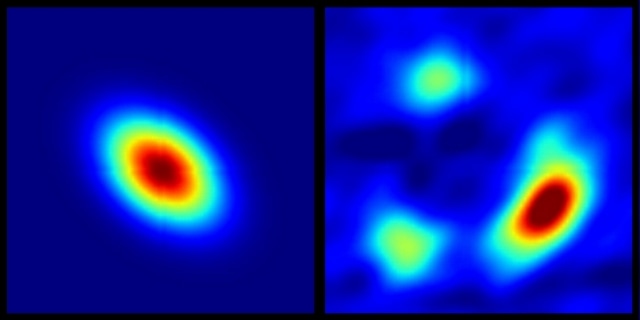Jul 1 2016
Mini-jets of material ejected from a central supermassive black hole appear to be the culprits behind faint radio wave emissions in ‘radio-quiet’ quasars. A study of gravitationally-lensed images of four radio-quiet quasars has revealed the structure of these distant galaxies in unprecedented detail. This has enabled astronomers to trace the radio emissions to a very small region at the heart of the quasars, and helped to solve a 50-year-old puzzle about their source. The results will be presented by Dr Neal Jackson at the National Astronomy Meeting in Nottingham on Friday, 1st July.
 Left: Reconstruction of the lensed radio-quiet quasar HS0810+2554 after removing the effects of the lensing. Right: the data from the Karl G. Jansky Very Large Array showing what the source looks like after passage through the lensing galaxy. The images are not to scale - the lensed image appears to be many times larger in the sky than the actual size of the source. Credit: N Jackson/NRAO
Left: Reconstruction of the lensed radio-quiet quasar HS0810+2554 after removing the effects of the lensing. Right: the data from the Karl G. Jansky Very Large Array showing what the source looks like after passage through the lensing galaxy. The images are not to scale - the lensed image appears to be many times larger in the sky than the actual size of the source. Credit: N Jackson/NRAO
“In radio-loud quasars, the intense radio emission clearly comes from vast jets of material blasted out from the region around a central black hole. By contrast, the radio emission from radio-quiet quasars is extremely feeble and difficult to see, so it has been hard to identify its source,” explained Jackson of the Jodrell Bank Centre for Astrophysics in Manchester. “To study most radio-quiet quasars, we will have to wait until future extremely large telescopes, like the Square Kilometre Array, come online. However, if we find radio-quiet quasars which are lensed by galaxies in front of them, we can use the increased brightness to be able to study them with today's radio telescopes.”
Gravitational lensing is a phenomenon where light from distant objects is warped by the gravitational field of massive objects in the foreground, a bit like light travelling through a glass lens. The mass distribution in a galaxy acts rather like a lens shaped like the bottom of a wineglass, and produces multiple images of background objects, with images stretched out into arcs and rings.
Jackson and colleagues used the Karl G. Jansky Very Large Array, in New Mexico, US, to study four examples of gravitational lens systems where the background quasar appears in a ring of four, distorted images. Two of the systems were also observed by the UK’s e-MERLIN array. After correcting for the distorting effects of the lens, the team were able to accurately measure the sizes of the radio-emitting regions in the sample of quasars.
“The cause of radio emissions in radio-quiet quasars has been the subject of debate. One theory suggested that they were caused by multiple explosions of individual supernovae in the galaxy surrounding the quasar,” said Jackson. “These new observations have allowed us to narrow down the emissions to a very small region, typical of an active nucleus – i.e. jets emanating from a supermassive black hole. We are currently working on some further data that we hope will confirm our preliminary findings. If so, we can rule out the supernova explanation, which would show radio emissions from a much larger area, and confirm that the processes driving radio-quiet quasars are the same as their loud counterpart, just on a smaller scale.”